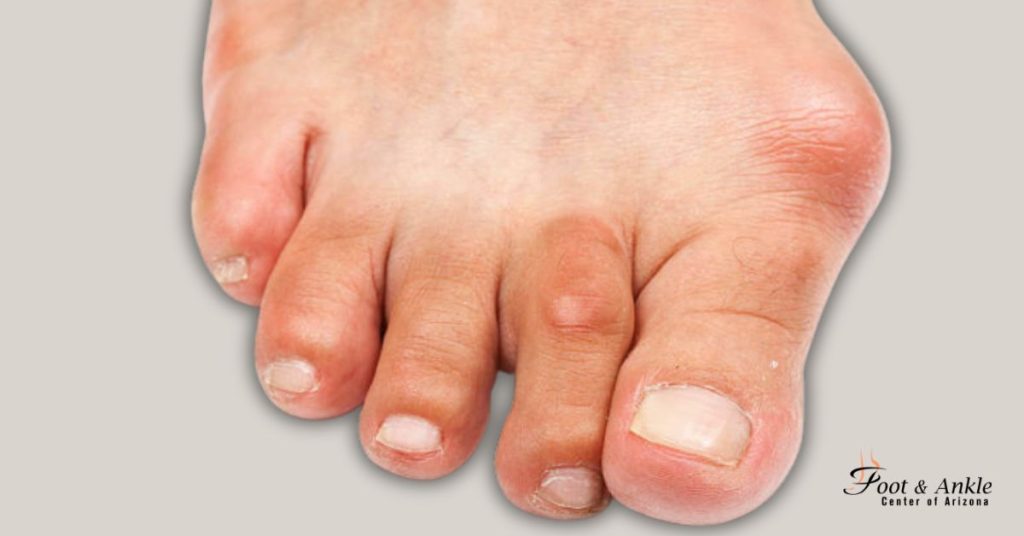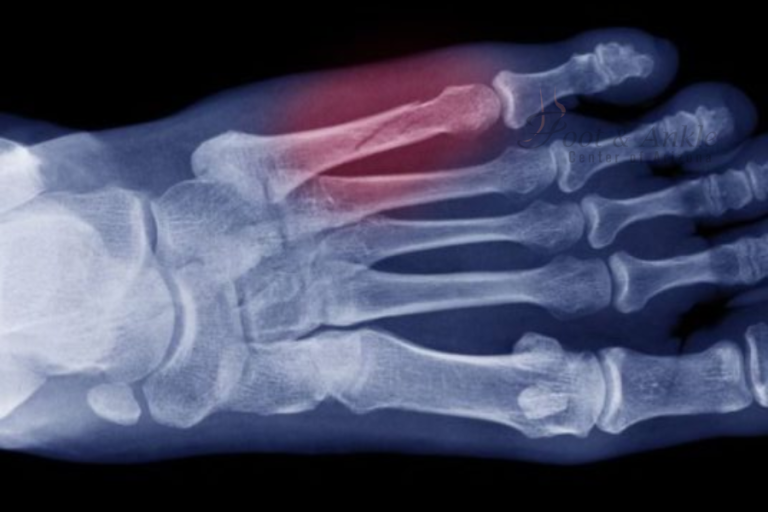A common cause of foot deformity is a bunion. Carrying out daily activities can be very uncomfortable and boring. It will help to know its symptoms, causes, and treatment options if you suffer from a bunion or think you might have one. In this article, we’ll talk about the signs and symptoms of bunions, what causes bunions, whether bunions get worse with age, why they can hurt, whether bunion splints work, and finally, treatment options and how to prevent them. We’ll discuss what to expect with bunion surgery and how to find specialized bunion treatment and foot care in your area.
What Are the Signs and Symptoms of Bunions?
A bony prominence at the base of the big toe characterizes bunions. This bony deformity is often accompanied by several signs and symptoms, including:
A Bulging Bump: The most visible sign of a bunion is a bulging bump on the outside of the base of your big toe. It occurs due to the metatarsal bone shifting and pushing outward.
Swelling, Redness, or Soreness: You may experience swelling, redness, or soreness around the big toe joint. This inflammation typically worsens with pressure from shoes.
Corns or Calluses: Corns or calluses may develop due to the constant friction between the first and second toes. These areas of thickened skin sometimes hurt and can be uncomfortable.
Chronic Pain: The pain in the bunions can be constant or intermittent and may vary in nature from a dull ache to sharp, stabbing sensations.
Limited movement of toes: A bunion can cause reduced movement in your big toe, whereby it becomes hard to bend or flex.
In case of such signs, you should always look for a health professional’s advice regarding proper diagnosis and treatment.
What Causes a Bunion?
Bunions develop gradually over time due to a combination of genetic and environmental factors. Here’s a closer look at what causes a bunion:
Bone Alignment Changes: A bunion forms when the bones in the foot shift from their normal alignment. This misalignment causes the metatarsal bone to push outward, creating the characteristic bump.
Shoe Choices: Tightly fitting or ill-fitting shoes, particularly the ones with a high heel and either pointed or narrow toe boxes, may fuel a bunion or actively cause it. The shoes compress toes into an unnatural position, making it more than likely to develop a bunion.
Genetics: Bunions can be partially genetic. If a person has a history of the issue within their family, then that individual would be most likely to suffer from it too, probably due to loose ligaments or bone structures inherited in such cases.
Foot Structure: People with a particular type of foot, such as flat feet or extremely high arches, can be more predisposed to bunions. Structurally, problems can put additional pressure on the big toe joint.
Trauma: In some cases, a bunion may be caused by trauma to the foot or toe.
Do Bunions Get Worse with Age?
Generally, bunions develop gradually. Several factors can influence their progression. Over time, bunions may worsen due to the following factors:
Progressive Bone Changes: The bones and the ligaments of your feet continue to shift as you age and grow older. This shift might get worse with time, which further adds to the bunion deformity.
Footwear: Years of tight or poorly fitting shoes can add to the progressive nature of bunions.
Weight Gain: The increased body weight can put more pressure on your feet, which can irritate any pre-existing bunions or even cause new ones.
Diminished Flexibility: With advancing age, your feet may become less flexible. As a result, handling bunions might become difficult and cause more pain.
While with age, bunions do tend to worsen, proper management and treatment can help in slowing down their progression and alleviating symptoms.
Why Does My Bunion Hurt?
A bunion can cause pain for several reasons:
Arthritis: The misalignment of the joint can lead to arthritis, causing inflammation and pain in the affected area.
Nerve Compression: The bone protrusion may press on a sensory nerve, leading to sharp or throbbing pain.
Altered Foot Mechanics: Changes in foot mechanics due to the bunion can result in pain in the ball of the foot, as well as discomfort from the altered gait.
Toe Rubbing: The big toe rubbing against smaller toes can cause irritation and pain, exacerbated by friction and pressure.
Footwear Pressure: Tight or poorly fitting shoes can put extra pressure on the bunion, increasing pain and discomfort.
If your bunion is causing significant pain, it’s important to seek medical advice to determine the best course of action for relief.
Do Bunion Splints Work?
Bunion splints and toe spacers are common conservative modalities to alleviate symptoms associated with bunions, though with variable effectiveness:
Temporary Relief: With the help of bunion splints and toe spacers, the toes are realigned, which lessens the pressure on the bunion and can also slightly alleviate pain and inflammation.
Refuting: There is no good evidence to support that bunion splints or toe spacers can reverse or cure a bunion deformation. They do not address the underlying bone alignment issues but can help manage symptoms.
Low Risk: Overall, bunion splints are low in risk and quite inexpensive. They, therefore, could be an effective approach for some individuals to alleviate symptoms.
Although bunion splints do not cure bunions, they are part of a holistic management plan that may include other treatments and alterations to a person’s lifestyle.
What Can I Do to Treat a Bunion?
The treatment forms for bunions may range from conservative to surgical interventions.
Footwear Modification: The patient should change to wider, more soothed shoes that do not put too much tension on the toes. Try avoiding high heels and shoes that compress the toes.
Padding and Cushions: This will reduce pressure and friction exerted on the bunion, thus giving you temporal comfort.
Ice and Pain Relief: Ice applied to the area will reduce inflammation and pain. Pain can be dulled using over-the-counter pain relievers.
Physical Therapy: Exercises and stretches are beneficial for improving foot alignment and strengthening, which can help relieve bunion pain.
Surgical correction: If conservative measures fail, the patient may be considered for surgical correction of the bunion. It is a procedure that essentially realigns the joint and excises the bony prominence. Most often, bunion surgery is done on an outpatient basis using sedation and local anesthetic.
What Is the Recovery for Bunion Surgery?
The recovery from bunion surgery involves the following steps:
Initial Recovery: You can start walking again with crutches in the first couple of weeks, never putting weight on the foot. Your doctor may or may not order a medical shoe or cast to be worn at least for eight weeks to protect the area from injury and for reduction of swelling.
Ambulation/Walking: Most patients can walk on their heels immediately but are usually limited from bearing weight on the front of their feet for several weeks.
Swelling and Pain: Swelling can last for several weeks. Adequate pain management with prescribed medications and adherence to post-operative instructions are very important to ensure a comfortable recovery.
Physical Therapy: Once the initial healing process is complete, physical therapy could be ordered to assist in regaining full motion and strength of the foot.
Recovery times will vary from person to person, and also upon the extent of the surgery itself; therefore, you must follow the advice of your surgeon for optimum results.
Are There Ways to Prevent Bunions?
While not all bunions can be prevented, certain measures can help reduce the risk of developing them:
Proper Footwear: Shoes must fit properly and support the foot. Avoid heels and shoes with a narrow toe box that cramps toes together.
Keep an Eye on Your Feet: Notice any changes in your feet and seek advice if there is persistent pain or discomfort.
Manage Foot Injuries: If you have a serious sprain or other injury to the great toe, seek professional advice to determine if any complications exist.
Maintain a Healthy Weight: Keeping a healthy weight puts less stress on your feet and makes it less likely for you to get bunions.
Genetic History: Since bunions can run in families, if you have a family history, monitor your feet to get early warning signs that will allow for early intervention.
Contact us for expert bunion care
Additional information on bunion treatment options is available from the Foot and Ankle Center of Arizona. Our doctors and medical professionals are here to provide relief from bunion pain to maintain good foot health.
Conclusion
Knowing the signs and symptoms of bunions, their causes, and treatment options can make all the difference in the effective management of this condition. You can use anything from conservative to surgical solutions to treat bunions or improve quality of life. Taking care of your feet regularly and getting timely interventions will go a long way in keeping them healthy.




